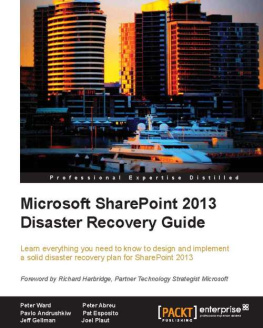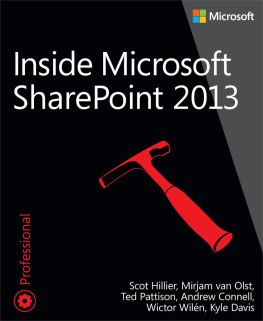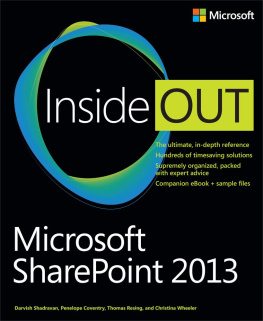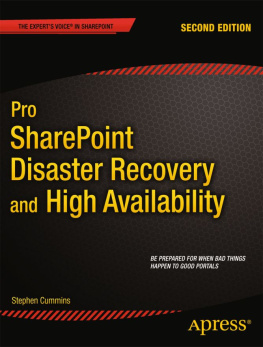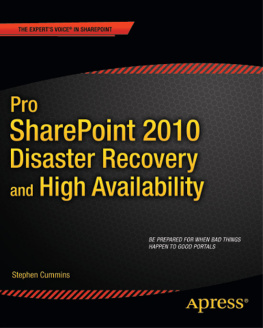Ward P. et al. - Microsoft SharePoint 2013 Disaster Recovery Guide
Here you can read online Ward P. et al. - Microsoft SharePoint 2013 Disaster Recovery Guide full text of the book (entire story) in english for free. Download pdf and epub, get meaning, cover and reviews about this ebook. genre: Computer / Business. Description of the work, (preface) as well as reviews are available. Best literature library LitArk.com created for fans of good reading and offers a wide selection of genres:
Romance novel
Science fiction
Adventure
Detective
Science
History
Home and family
Prose
Art
Politics
Computer
Non-fiction
Religion
Business
Children
Humor
Choose a favorite category and find really read worthwhile books. Enjoy immersion in the world of imagination, feel the emotions of the characters or learn something new for yourself, make an fascinating discovery.
- Book:Microsoft SharePoint 2013 Disaster Recovery Guide
- Author:
- Genre:
- Rating:4 / 5
- Favourites:Add to favourites
- Your mark:
Microsoft SharePoint 2013 Disaster Recovery Guide: summary, description and annotation
We offer to read an annotation, description, summary or preface (depends on what the author of the book "Microsoft SharePoint 2013 Disaster Recovery Guide" wrote himself). If you haven't found the necessary information about the book — write in the comments, we will try to find it.
. .
Given that Microsofts SharePoint platform has become a missioncritical application where business operations just cannot run without complete uptime of this technology, disaster recovery is one of the most important topics when it comes to SharePoint. Yet, support and an appropriate approach for this technology are still difficult to come by, and are often vulnerable to technical oversight and assumptions.Microsoft SharePoint 2013 Disaster Recovery Guide looks at SharePoint disaster recovery and breaks down the mystery and confusion that surrounds what is a vital activity to any technical deployment. This book provides a holistic approach with practical recipes that will help you to take advantage of the new 2013 functionality and cloud technologies.You will also learn how to plan, test, and deploy a disaster recovery environment using SharePoint, Windows Server, and SQL tools. We will also take a look at datasets and custom development. If you want to have an approach to disaster recovery that gives you peace of mind, then this is the book for you.What you will learn from this book:
Learn why disaster recovery is a struggle to understand and implement.
Learn how to support optimized application recovery times with tiered service levels.
Inherit a missioncritical environment that has no disaster recoveryplans.
Get familiar with backup and restore procedures that are available to an administrator as well as the pros and cons of each.
Learn about Disaster recovery in regards to virtualization and the cloud.
Architect data in SharePoint with disaster recovery in mind.
Build confidence and refine disaster recovery plans with more frequent testing.
Create a theme for use with your video player.Who this book is written for:
This book is great for both SharePoint and SQL administrators new to the SharePoint 2013 architecture, and who are looking to get a good grounding in how to use implement a solid disaster recovery plan. Its assumed that you have some experience in SharePoint and Windows Server and, as well be familiar with SQL. iPAD Amazon Kindle, PC , Cool Reader, Calibre, Adobe Digital Editions
Ward P. et al.: author's other books
Who wrote Microsoft SharePoint 2013 Disaster Recovery Guide? Find out the surname, the name of the author of the book and a list of all author's works by series.

